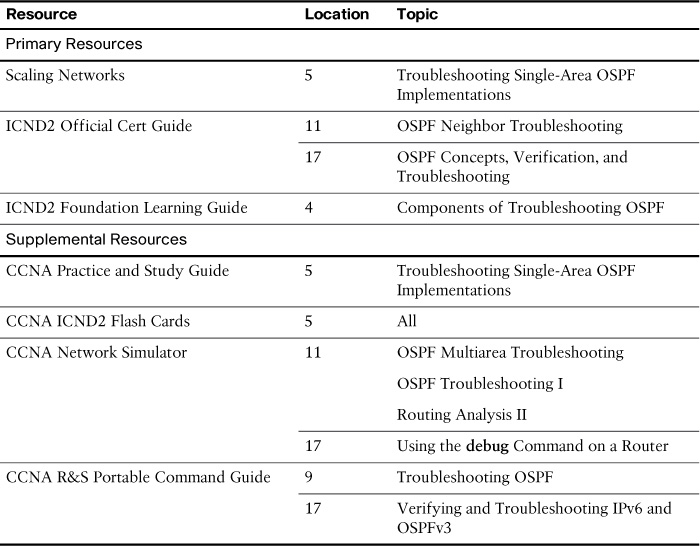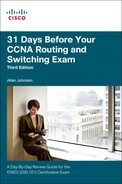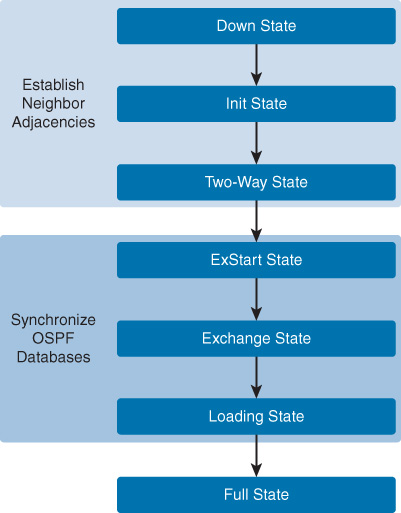Day 11. Troubleshooting OSPF
CCNA 200-101 ICND2 Exam Topics
![]() Troubleshoot and resolve OSPF problems
Troubleshoot and resolve OSPF problems
Key Topics
Today, the review focuses specifically on troubleshooting Open Shortest Path First (OSPF) Protocol implementations. You first review some crucial OSPF operational considerations. Then you learn a systematic method for OSPF show commands to isolate issues.
OSPF Operational Considerations
Understanding how OSPF operates is fundamental to troubleshooting any OSPF issues. Key to this understanding is the concept of the states OSPF transitions through on its way to adjacency with a neighbor.
OSPF States
Figure 11-1 lists the OSPF states. When troubleshooting OSPF neighbors, be aware that the FULL or 2WAY states are normal. All other states are transitory.
OSPF Adjacency
The lack of adjacency is a common issue in OSPF troubleshooting because the two OSPF neighbors must agree on a number of settings. OSPF adjacencies will not form if one or more of the following do not match:
![]() The interfaces are not on the same network.
The interfaces are not on the same network.
![]() OSPF network types do not match.
OSPF network types do not match.
![]() OSPF Hello or Dead timers do not match.
OSPF Hello or Dead timers do not match.
![]() The interface to the neighbor is incorrectly configured as passive.
The interface to the neighbor is incorrectly configured as passive.
![]() There is a missing or incorrect OSPF network command.
There is a missing or incorrect OSPF network command.
![]() Authentication is misconfigured.
Authentication is misconfigured.
OSPF Troubleshooting Commands
When trying to isolate an OSPFv2 routing issue, you will find the following commands useful:
![]() show ip protocols: Used to verify vital OSPF configuration information, including the OSPF process ID, the router ID, networks the router is advertising, the neighbors the router is receiving updates from, and the default administrative distance, which is 110 for OSPF.
show ip protocols: Used to verify vital OSPF configuration information, including the OSPF process ID, the router ID, networks the router is advertising, the neighbors the router is receiving updates from, and the default administrative distance, which is 110 for OSPF.
![]() show ip ospf neighbor: Used to verify that the router has formed an adjacency with its neighboring routers.
show ip ospf neighbor: Used to verify that the router has formed an adjacency with its neighboring routers.
![]() show ip ospf interface: Used to display the OSPF parameters configured on an interface, such as the OSPF process ID, area, cost, and timer intervals.
show ip ospf interface: Used to display the OSPF parameters configured on an interface, such as the OSPF process ID, area, cost, and timer intervals.
![]() show ip ospf: Used to examine the OSPF process ID and router ID. This command also displays the OSPF area information, in addition to the last time the SPF algorithm was calculated.
show ip ospf: Used to examine the OSPF process ID and router ID. This command also displays the OSPF area information, in addition to the last time the SPF algorithm was calculated.
![]() show ip route ospf: Used to display only the OSPF learned routes in the routing table.
show ip route ospf: Used to display only the OSPF learned routes in the routing table.
![]() clear ip ospf process: Used to reset the OSPFv2 neighbor adjacencies.
clear ip ospf process: Used to reset the OSPFv2 neighbor adjacencies.
Figure 11-2 illustrates a method for using these commands in a systematic way.
You can use the same process to troubleshoot OSPFv3 implementations. Simply replace the ip with ipv6 in the list of OSPF-specific show commands:
![]() show ipv6 protocols
show ipv6 protocols
![]() show ipv6 ospf neighbor
show ipv6 ospf neighbor
![]() show ipv6 ospf interface
show ipv6 ospf interface
![]() show ipv6 ospf
show ipv6 ospf
![]() show ipv6 route ospf
show ipv6 route ospf
![]() clear ipv6 ospf process
clear ipv6 ospf process



